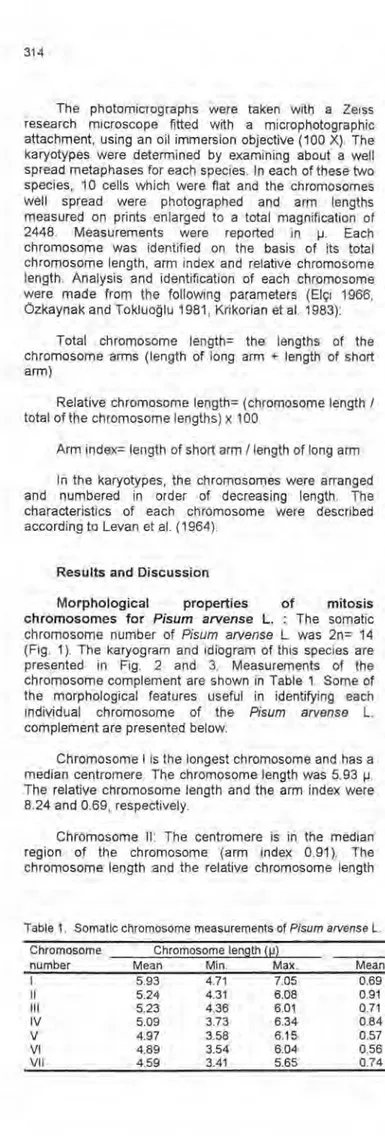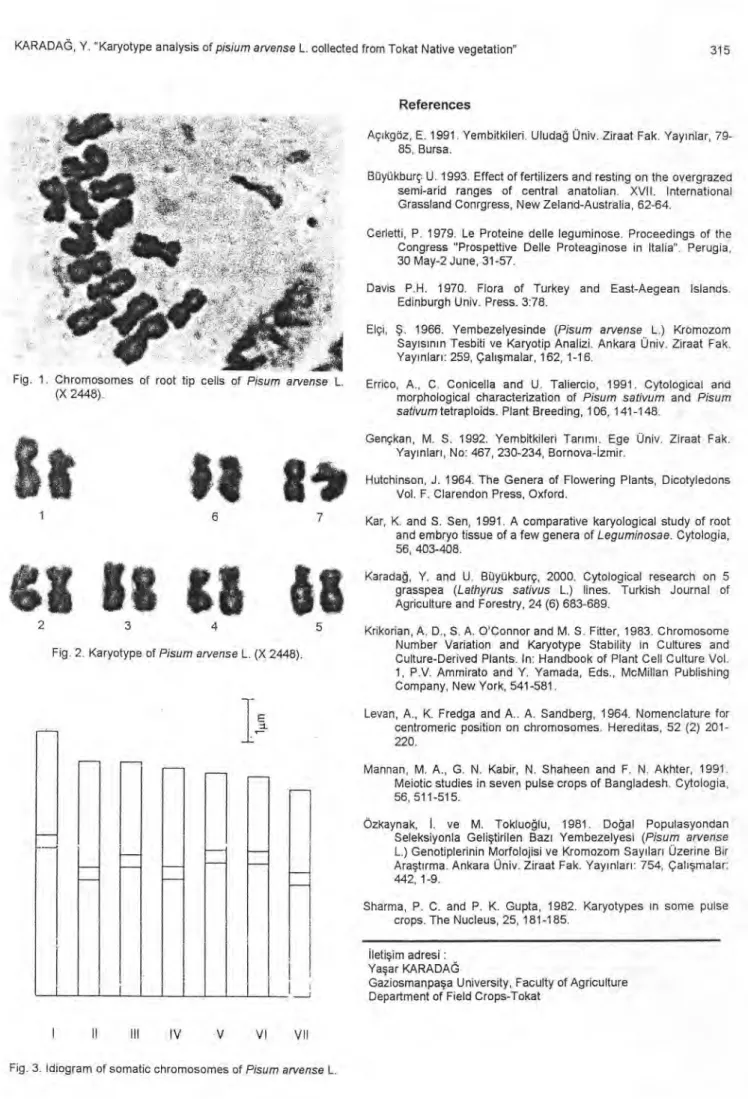TARIM BILİMLERI DERGISI 2003, 9 (3) 313-315
Karyotype Analysis of
Pisum arvense
L. Collected from
Tokat Native Vegetation
Yaşar KARADAĞ'
Geliş Tarihi: 12.07.2002
Abstract: This research was conducted to determine karyotype analysis of Pisum arvense L. occurred in native vegetation of Tokat region. After the seeds were germinated, they were stained by feulgen and karyotype analysis was carried out with obtained cells by using the squash method. The results of the cytological studies that the chromosome numbers of Pisum arvense L. were 2n= 14. Four chromosomes of the Pisum arvense L. were submedian and ten chromosomes were median. In addition, the chromosome length, the arm index and the relative chromosome length in
Pisum arvense L. were 4.59-5.93 p, 0.56-0.91 and 6.38-8.24, respectively. Key Words: Pisum arvense L., karyotype, native vegetation, karyogram, idiogram
Tokat Do
ğ
al Vejetasyonundan Toplanan Yem Bezelyesinin
(Pisum arvense
L.)
Karyotip Analizi
Özet: Bu araştırma, Tokat Bölgesi vejetasyonunda doğal olarak bulunan yem bezelyesinin karyotip analizlerinin saptanması amacıyla yapılmıştır. Vejetasyondan toplanan tohumlar çimlendirildikten sonra kök uçları feulgen ile boyanmış ve ezme preparat tekniği ile elde edilen hücrelerden karyotip analizleri yapılmıştır. Sitolojik çalışmalarda
Pisum arvense L.'nin kromozom sayısı 2n= 14 olarak bulunmuştur. Yapılan incelemeler sonucunda Pisum arvense L.'de 14 kromozomdan 4 tanesinin submedian, 10 tanesinin de median olduğu saptanmıştır. Ayrıca, Pisum arvense L.'de kromozom uzunluğu, kol indeksi ve oransal kromozom uzunlukları sırasıyla 4.59-5.93 p, 0.56-0.91 ve 6.38-8.24 olarak saptanmıştır.
Anahtar Kelimeler: Pisum arvense L., karyotip, doğal vejetasyon, karyogram, idiogram,
Introduction
The native pastures of Tokat have a great diversity of grass and legume species. Cattle feeding is based mainly on these pastures (Büyükburç 1993). The family Leguminosae comprises of about 690 genera and more than 17 000 species (Hutchinson 1964). Forage legumes are an important protein source for livestock and soil fertility. Due to the high protein contents of grain legumes seeds, ranges from 20 % to 40 % (Cerletti 1979). Pisum
arvense L., one of the forage legumes, belongs to the tribe Vicieae of the sub-family Papilionaceae (Gençkan 1992). Pisum has tendrillous, annual and often climbing plants
and used for human, animal nutrition and green manure
(Davis 1970, Açıkgöz 1991). Karyotype analysis in plants
are basic cytological studies to identify genotypes and provide useful information for plant breeding.
Elçi (1966) reported that Pisum arvense L. has 14
chromosomes, 10 subterminal and 4 submedian, with no satellites or secondary constrictions and the length of the chromosomes varied from 4.69 p to 6.26 N. Elçi (1966) also reported that the chromosomes have subterminal or submedian centromeres and the relative chromosome length and the arm index varied between 6.37-8.56 and
0.49-0.89, respectively. Özkaynak and Tokluoğlu (1981)
found that Pisum arvense L. has 14 chromosomes. They also reported that the chromosome length and the relative chromosome length varied between 3.86 - 5.92 p and
5.64-8.86, respectively. In addition, Kar and Sen (1991), Mannan et al. (1991) and Errico et al. (1991) obtained that the chromosome number of Pisum sativum L. was 2n= 14. Kar and Sen (1991) reported that the chromosome lengths of Pisum sativum L. varied from 4.5-5.5 p. Kar and Sen (1991) also reported that the chromosomes of Pisum
safivum L. have nearly submedian to submedian primary
constriction.
The present work aims to gather basic information on this species for its better characterization, and especially to establish the basis for future breeding projects.
Materials and Methods
The material (Pisum arvense L.) used in this study was collected from the native vegetation of Tokat region. The seeds of Pisum arvense L. were then germinated on moist filter paper in the laboratory at 25 °C. The growing
root tips, 1.0 to 1.5 mm long, were excised and pretreated
in a saturated solution of a-bromonaphthalene for 3 hours. After pretreatment the root tips were fixed in glaciaI acetic acid for 1/2 hour. The chromosomes were stained by the
Feulgen method after hydrolysis in 1 N HCI for 12 min at
60 °C (Sharma and Gupta 1982, Karadağ and Büyükburç
2000). Root tips were then squashed in 1 % acetocarmine (Mannan et al. 1991).
314 TARIM BİLİMLERİ DERGİSI 2003, Cilt 9 ; Sayı 3
The photomicrographs were taken with a Zeiss research microscope fitted with a microphotographic attachment, using an oil immersion objective (100 X). The karyotypes were determined by examining about a well spread metaphases for each species. In each of these two species, 10 cells which were flat and the chromosomes well spread were photographed and arm lengths measured on prints enlarged to a total magnification of 2448. Measurements were reported in N. Each chromosome was identified on the basis of its total chromosome length, arm index and relative chromosome
length. Analysis and identifıcation of each chromosome
were made from the following parameters (Elçi 1966,
Özkaynak and Tokluoğlu 1981, Krikorian et al. 1983):
Total chromosome length= the lengths of the chromosome arms (length of long arm + length of short arm)
Relative chromosome length= (chromosome length / total of the chromosome lengths) x 100
Arm index= length of short arm / length of long arm In the karyotypes, the chromosomes were arranged and numbered in order of decreasing length. The characteristics of each chromosome were described according to Levan et al. (1964).
Results and Discussion
Morphological properties of mitosis chromosomes for Pisum arvense L. : The somatic
chromosome number of Pisum arvense L. was 2n= 14
(Fig. 1). The karyogram and idiogram of this species are presented in Fig. 2 and 3. Measurements of the chromosome complement are shown in Table 1. Some of the morphological features useful in identifying each
individual chromosome of the Pisum arvense L.
complement are presented below:
Chromosome I is the longest chromosome and has a median centromere. The chromosome length was 5.93 N. The relative chromosome length and the arm index were 8.24 and 0.69, respectively.
Chromosome Il: The centromere is in the median region of the chromosome (arm index 0.91). The chromosome length and the relative chromosome length
were 5.24 p and 7.29, respectively. This is the most symmetrical chromosome of the complement.
Chromosome III: The arm index and the relative chromosome length were 0.71 and 7.28, respectively. The chromosome length was 5.23 N. The centromere is located in the median region.
Chromosome IV: This is the most asymmetrical chromosome of the complement (arm index 0.84). The chromosome length and the relative chromosome length were 5.09 p and 7.08, respectively. The centromere is in the median region of the chromosome.
Chromosome V: It is a submetacentric chromosome. The chromosome length and the arm index were 4.97 p and 0.57, respectively. Also, the relative chromosome length was 6.92.
Chromosome VI: The chromosome length and the relative chromosome length were 4.89 g and 6.80, respectively. The position of the centromer is submedian on chromosome VI. The arm index was 0.56. This is the most asymmetrical chromosome of the complement.
Chromosome VII: This is the shortest chromosome of the complement. The chromosome length and the relative chromosome length were 4.59 g and 6.38, respectively. The centromere is in the median region (arm index 0.74).
Research findings showed that somatic chromosome number of Pisum arvense L. was 2n= 14. Elçi (1966) and
Özkaynak and Tokluoğlu (1981) reported that the
chromosome number was 2n= 14 for Pisum arvense L. In addition, Kar and Sen (1991) and Mannan et al. (1991) found that the chromosome number of Pisum sativum L.
was 2n=14. No satellite is present on the karyotype of the
species. Similar results were reported by some other
researchers (Elçi 1966, Özkaynak and Tokluoğlu 1981,
Kar and Sen 1991). Four chromosomes of Pisum arvense
L. were submedian and ten chromosomes were median. Moreover, the chromosome length, the arm index and the relative chromosome length were 4.59-5.93 p, 0.56-0.91 and 6.38-8.24, respectively. Generally, it is observed that the chromosomes of Pisum arvense L. have normal structure. There are not big differences, from the view point of the size of the chromosomes. These results
confırm the findings of Elçi (1966) and Özkaynak and
Tokluoğlu (1981).
Table 1. Somatic chromosome measurements of Pisum arvense L.
Chromosome Chromosome length (p) Arm index Relatıve chromosome length
number Mean Min. Max. Mean Min. Max. Mean Min. Max.
I 5.93 4.71 7.05 0.69 0.68 0.72 8.24 7.06 9.24 Il 5.24 4.31 6.08 0.91 0.88 0.97 7.29 6.23 8.16 III 5.23 4.36 6.01 0.71 0.66 0.81 7.28 6.35 7.43 IV 5.09 3.73 6.34 0.84 0.83 0.86 7.08 6.20 7.39 V 4.97 3.58 6.15 0.57 0.46 0.80 6.92 5.92 7.82 VI 4.89 3.54 6.04 0.56 0.41 0.86 6.80 5.97 7.43 VII 4.59 3.41 5.65 0.74 0.67 0.84 6.38 5.61 6.71
Fig. 1. Chromosomes of root tip cells of Pisum arvense L. (X 2448).
1 6 7
2 3 4 5
Fig. 2. Karyotype of Pisum arvense L. (X 2448).
KARADAĞ, Y. "Karyotype analysis of pisium arvense L. collected from Tokat Native vegetation" 315
References
Açıkgöz, E. 1991. Yembitkileri. Uludağ Üniv. Ziraat Fak. Yayınlar, 79- 85, Bursa.
Büyükburç U. 1993. Effect of fertilizers and resting on the overgrazed semi-arid ranges of central anatolian. XVII. International Grassland Conrgress, New Zeland-Australia, 62-64.
Cerletti, P. 1979. Le Proteine delle leguminose. Proceedings of the Congress "Prospettive Delle Proteaginose in Italia". Perugia, 30 May-2 June, 31-57.
Davis P.H. 1970. Flora of Turkey and East-Aegean Islands. Edinburgh Univ. Press. 3:78.
Elçi, Ş. 1966. Yembezelyesinde (Pisum arvense L.) Kromozom Sayısının Tesbiti ve Karyotip Analizi. Ankara Üniv. Ziraat Fak. Yayınları: 259, Çalışmalar, 162, 1-16.
Errico, A., C. Conicella and U. Taliercio, 1991. Cytological and morphological characterization of Pisum sativum and Pisum sativum tetraploids. Plant Breeding, 106, 141-148.
Gençkan, M. S. 1992. Yembitkileri Tarımı. Ege Üniv. Ziraat Fak. Yayınları, No: 467, 230-234, Bornova-İzmir.
Hutchinson, J. 1964. The Genera of Flowering Plants, Dicotyiedons Vol. F. Clarendon Press, Oxford.
Kar, K. and S. Sen, 1991. A comparative karyological study of root and embryo tissue of a few genera of Leguminosae. Cytologia, 56, 403-408.
Karadağ, Y. and U. Büyükburç, 2000. Cytological research on 5 grasspea (Lathyrus sativus L.) lines. Turkish Journal of Agriculture and Forestry, 24 (6) 683-689.
Krikorian, A. D., S. A. O'Connor and M. S. Fitter, 1983. Chromosome Number Variation and Karyotype Stability in Cultures and Culture-Derived Plants. In: Handbook of Plant Cell Culture Vol. 1, P.V. Ammirato and Y. Yamada, Eds., McMillan Publishing Company, New York, 541-581.
Levan, A., K. Fredga and A.. A. Sandberg, 1964. Nomenclature for centromeric position on chromosomes. Hereditas, 52 (2) 201- 220.
Mannan, M. A., G. N. Kabir, N. Shaheen and F. N. Akhter, 1991. Meiotic studies in seven pulse crops of Bangladesh. Cytologia, 56, 511-515.
Özkaynak, İ. ve M. Tokluoğiu, 1981. Doğal Populasyondan Seleksiyonla Geliştirilen Bazı Yembezelyesi (Pisum arvense L.) Genotiplerinin Morfolojisi ve Kromozom Sayıları Üzerine Bir Araştırma. Ankara Üniv. Ziraat Fak. Yayınları: 754, Çalışmalar: 442, 1-9.
Sharma, P. C. and P. K. Gupta, 1982. Karyotypes in some pulse crops. The Nucleus, 25, 181-185.
İletişim adresi : Yaşar KARADAĞ
Gaziosmanpaşa University, Faculty of Agriculture Department of Field Crops-Tokat

